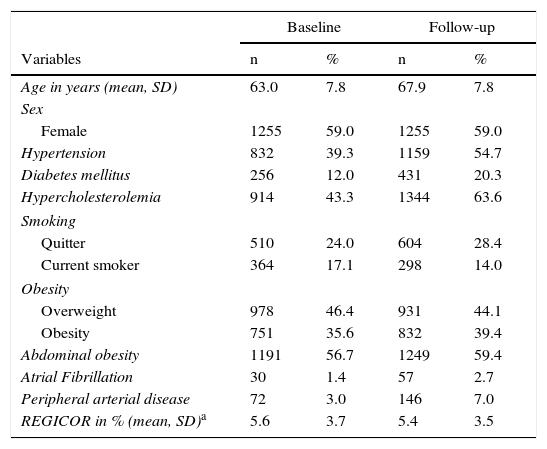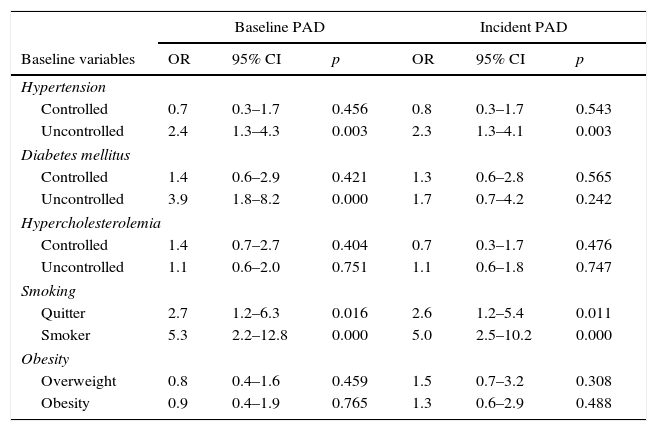Although cardiovascular risk factors (CVRF) are well known, their degree of control is not optimal. The aim of this study is to assess the evolution and control of CVRFs after 5 years of monitoring a population-based cohort and their association with the incidence of peripheral arterial disease (PAD).
Material and methodProspective cohort study recruited between 2006 and 2008. Second phase between 2011 and 2012. An ankle–brachial index was determined for all participants in both phases. Demographic variables, CVRF and previous cardiovascular events, blood pressure, total cholesterol and its fractions (HDL, LDL), triglycerides, glucose and glycosylated haemoglobin levels in diabetic patients and the cardiovascular risk score according to the REGICOR table were recorded.
ResultsA total of 2125 individuals were analyzed. We observed an increase in the prevalence of hypertension (HT) (15.4%), diabetes (DM) (8.2%) and hypercholesterolemia (20.4%), with no changes in obesity and smoking. The cardiovascular risk determined on the basis of the REGICOR table remained at around 5.5%. We observed an increased control of CVRF throughout the follow-up period, except in the case of DM and obesity. In the multivariate analysis, uncontrolled HT 2-folded the risk of onset of PAD (odds ratio [OR] 2.3; 95% confidence interval [95% CI] 1.3–4.1), whereas smoking 5-folded this risk (OR 5.0; 95% CI 2.5–10.2).
ConclusionsSmoking and uncontrolled HT increase the risk of onset of PAD in this population. Despite the increase in drug treatments, the control of CVRFs continues to be suboptimal.
Los factores de riesgo cardiovascular (FRCV) son bien conocidos, pero su grado de control no es óptimo. Este trabajo pretende valorar la evolución y el control de los FRCV clásicos tras 5 años de seguimiento de una cohorte poblacional y su relación con la incidencia de arteriopatía periférica (AP).
Material y métodoEstudio de cohortes prospectivo. Selección de pacientes 2006-2008; segunda visita entre 2011-2012. En ambas fases se realizó un índice tobillo-brazo en condiciones estandarizadas. Se registraron variables demográficas, antecedentes y FRCV, presión arterial, perfil lipídico, glucosa y hemoglobina glucosilada en pacientes diabéticos y cálculo del riesgo cardiovascular mediante REGICOR.
ResultadosFueron analizados 2.125 individuos. Se incrementó la prevalencia de hipertensión arterial (HTA) en un 15,4%, en un 8,2% la diabetes (DM) y en un 20,4% la hipercolesterolemia, manteniéndose estables la obesidad y el tabaquismo. REGICOR se mantuvo alrededor de 5,5%. Se incrementó el control de los FRCV durante el seguimiento, excepto para la DM y la obesidad. En el análisis multivariante la HTA no controlada presentó un riesgo de más del doble para AP incidente (odds ratio [OR] 2,3; intervalo de confianza al 95% [IC 95%] 1,3-4,1), y el tabaquismo, de 5 veces (OR 5,0; IC 95% 2,5-10,2).
ConclusionesTabaquismo y HTA mal controlados incrementan el riesgo para AP en esta población. A pesar del aumento del tratamiento farmacológico persiste un control subóptimo de los FRCV.












